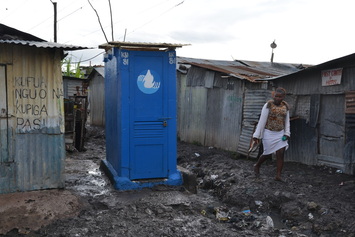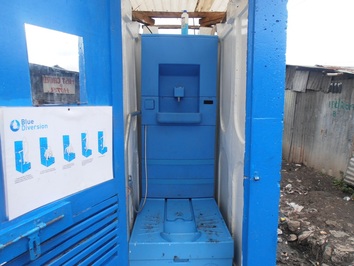Field test Nairobi, Kenya in 2014
|
The field work was conducted in collaboration with Sanergy who have built a network of 372 urine diverting toilets in and around Mukuru, an informal settlement in the industrial area of Nairobi. A service team collects waste from every toilet on a daily basis and delivers the waste to a semi-centralized treatment site outside of Nairobi. The field test site was chosen because Sanergy’s approach is similar to the one that is envisioned for the Blue Diversion system and to test the Blue Diversion Toilet in a more demanding environment compared to the first field test which took place in Kampala, Uganda in 2013. After the first field test the Blue Diversion Toilet had been reduced in size and simplified. The goal of the second field test in Nairobi was to validate the totally reengineered working model under real conditions.
|
The field test was accompanied by a social science study funded by Eawag. 60 interviews with regular users and 300 interviews with one time users were collected. Furthermore, a household survey with 1’400 people was conducted to gather information about the current sanitation situation in the two informal settlements Mukuru and Kibera. Read a little more about the results and the sanitation situation in informal settlements in our blog
|
Postitive results:
|
Observations of 227 latrines during the household survey showed that retrofitting is possible in 50% of the toilets. For the field test the doorframe had to be removed temporary to install the toilet. This minor adaption is necessary for most of the superstructures as only 10% of the doors are large enough to fit the Blue Diversion toilet. Yet 72% of the eligible latrines are built with iron sheets and are therefore easier to adapt than other superstructures. Additionally, the roof would also need to be raised in 30% of the toilets with a suitable surface area. These minor adjustments would allow avoiding the construction of an expensive new superstructure (~40% of on-site sanitation costs in East Africa).
Learn more about the latrine dimensions and the calculations of retrofitting in the following documents:
Learn more about the latrine dimensions and the calculations of retrofitting in the following documents:
|
| ||||||
|
| ||||||
|
| ||||||
The
field test highlighted the requirement for the following improvements of the
Blue Diversion Toilet:
- The
hydraulic system needs further simplification and the number of components needs
to be reduced
- Further
development of the electronics and the software to make it more robust and less
vulnerable to failures
- Further
design work should focus on maintenance and servicing aspects. The
collaboration with Sanergy gave important insights into the running of a
reliable collection system and its challenges.
- Adapt the squatting pan for muddy and water logged areas e.g. by expanding the product range with sitting module or an in-between sit-squat module to prevent mud from clogging the mechanism.



